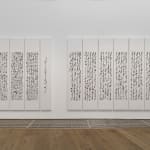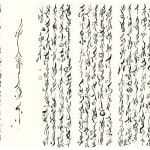Tao Aimin 陶艾民
Nv Shu: Mother and Daughter 女书·母女, 2019
Ink on paper,audio recording 纸本水墨,音频
180 x 45 cm x 12
In her most recent body of work, Tao Aimin picks up the thread the secret language from the washboard, paying homage to the power of sharing the intimate secrets of...
In her most recent body of work, Tao Aimin picks up the thread the secret language from the washboard, paying homage to the power of sharing the intimate secrets of everyday life. Studying what has been hailed as a “secret language of women” – nü shu 女书 – she joins a small group of local women from Jiangyong county in her native Hunan Province, and scholars of linguistics, women’s studies, and Chinese traditional culture, to help, through her artistic practice, to preserve and re-invigorate this unique writing system developed by and passed down through generations of Hunanese women that is now dying out.
Just as she spent years collecting rural women’s washboards, she has begun collecting women’s secrets, stories, confessions, wisdom, and knowledge, from which she creates powerful contemporary nü shu works, reinvigorating the time-honored forms of the genre with the urgency and relevance of contemporary content. By using nü shu in her art practice, adopting many of its traditional forms (including letters, books, fans, embroidery, couplets, and other calligraphic forms) to express contemporary predicaments, preoccupations, and experiential realities of modern women, she infuses this dying art of sharing women’s secrets with new context of usage.
The secrets of mothers and daughters is the theme “Nü Shu: Mother and Daughter” (2019). In a bold, large-scale, experimental calligraphic work two stories—one by a mother, and the other by her daughter—are juxtaposed into a single multipanel work. The mother and daughter in this work believe in the necessity of breaking silence and fighting back against patriarchal silencing, and the systemic misogyny and sexual violence against women that is rampant in every society on this earth, thus they have agreed that their stories be shared in public. In the first story, the daughter recounts being sexually molested by a man in a store as a prepubescent adolescent. The mother in the second story recounts her reaction to her daughter’s molestation. How furious it made her. She talked about how she had also been molested as a girl, several times, but always blamed herself, “I vowed that things would be different for her. I promised myself that I would teach her to know her worth, to trust her own judgment, and to be strong and brave enough to say ‘no’ if anyone tried to prey on her. When she told me what had happened that day, I was both mortified that she had experienced this, but also so proud of her for saying ‘no’ and trusting me enough to share her secret. A secret shared is not nearly as heavy as the crushing weight of one that can break you in your silence.”
Just as she spent years collecting rural women’s washboards, she has begun collecting women’s secrets, stories, confessions, wisdom, and knowledge, from which she creates powerful contemporary nü shu works, reinvigorating the time-honored forms of the genre with the urgency and relevance of contemporary content. By using nü shu in her art practice, adopting many of its traditional forms (including letters, books, fans, embroidery, couplets, and other calligraphic forms) to express contemporary predicaments, preoccupations, and experiential realities of modern women, she infuses this dying art of sharing women’s secrets with new context of usage.
The secrets of mothers and daughters is the theme “Nü Shu: Mother and Daughter” (2019). In a bold, large-scale, experimental calligraphic work two stories—one by a mother, and the other by her daughter—are juxtaposed into a single multipanel work. The mother and daughter in this work believe in the necessity of breaking silence and fighting back against patriarchal silencing, and the systemic misogyny and sexual violence against women that is rampant in every society on this earth, thus they have agreed that their stories be shared in public. In the first story, the daughter recounts being sexually molested by a man in a store as a prepubescent adolescent. The mother in the second story recounts her reaction to her daughter’s molestation. How furious it made her. She talked about how she had also been molested as a girl, several times, but always blamed herself, “I vowed that things would be different for her. I promised myself that I would teach her to know her worth, to trust her own judgment, and to be strong and brave enough to say ‘no’ if anyone tried to prey on her. When she told me what had happened that day, I was both mortified that she had experienced this, but also so proud of her for saying ‘no’ and trusting me enough to share her secret. A secret shared is not nearly as heavy as the crushing weight of one that can break you in your silence.”




